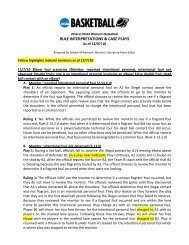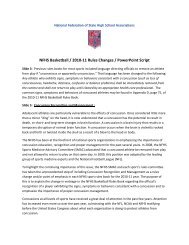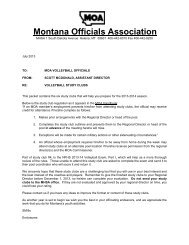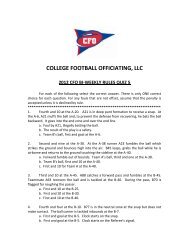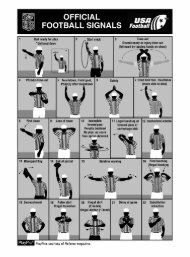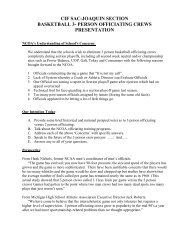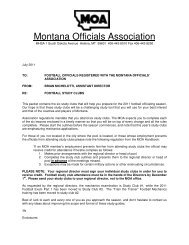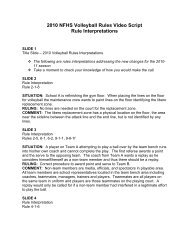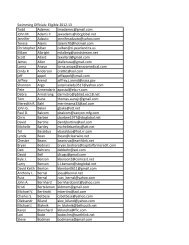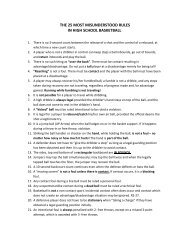(PDF). - NCAA Wrestling Officiating
(PDF). - NCAA Wrestling Officiating
(PDF). - NCAA Wrestling Officiating
You also want an ePaper? Increase the reach of your titles
YUMPU automatically turns print PDFs into web optimized ePapers that Google loves.
WR-16<br />
Rule 2 / Definitions<br />
2.1.4 Optional Offensive Starting Position. Wrestlers selecting the optional<br />
starting position must indicate their intent to the referee. The referee shall<br />
inform the defensive wrestler of the offensive wrestler’s intention and allow<br />
the defensive wrestler to adjust. The referee shall direct the offensive wrestler<br />
to assume the optional offensive starting position.<br />
The offensive wrestler may select a position on either side or to the rear<br />
of the defensive wrestler with all weight supported by both feet, one knee or<br />
both knees. The offensive wrestler is to place both hands on the opponent’s<br />
back (area between neck and waist), thumbs touching. Only the hands of the<br />
offensive wrestler are to be in contact with the defensive wrestler.<br />
The offensive wrestler is not to place one or both feet or knees between<br />
the opponent’s feet or legs, or in front of the forward starting line or the line<br />
extended. In addition, the offensive wrestler is not to straddle the opponent.<br />
(See Illustration Nos. 12 and 13.)<br />
2.1.5 Granting an Escape. Before assuming an offensive starting position, the<br />
offensive wrestler may signal to the referee the neutral position. The defensive<br />
wrestler is awarded an escape, and wrestling begins from the neutral position.<br />
2.2 Stalemate<br />
When the contestants are interlocked in a position other than a pinning situation<br />
in which neither wrestler is improving position, the referee shall stop the match<br />
as soon as possible; wrestling will be resumed as for out of bounds. (See Rule<br />
2.5.)<br />
2.3 Position of Advantage<br />
The offensive wrestler maintains the position of advantage until the opponent<br />
(defensive wrestler) is awarded an escape or a reversal by the referee.<br />
2.4 In Bounds<br />
Contestants are considered to be in bounds if any part of either wrestler is on<br />
or inside the boundary line. <strong>Wrestling</strong> shall continue as long as either wrestler<br />
remains in bounds. It is the responsibility of both wrestlers to maintain action<br />
by staying in bounds. For the purpose of awarding a point(s) at the edge of the<br />
wrestling area, a point(s) shall be awarded when control is established or lost<br />
while any part of either wrestler finishes on the mat in bounds.<br />
When the defensive wrestler’s back is exposed to the mat in a pinning situation<br />
while any part of either wrestler is in bounds, near-fall points may be earned or<br />
a fall called. (See Illustration Nos. 59 and 60.)<br />
If there is no action at the edge of the mat, the referee may stop the wrestling.<br />
2.5 Resumption of <strong>Wrestling</strong> After Out of Bounds<br />
The contestants at the resumption of a match shall be in the neutral or the<br />
starting position on the mat as determined by the position held upon going out<br />
of bounds. If the wrestlers are neutral, the match shall be resumed with both<br />
wrestlers opposite each other and with one foot or both feet on the green or red<br />
area of the starting lines. If one wrestler has the advantage, that contestant will<br />
take the offensive starting position at the center of the mat, and the opponent will<br />
assume the defensive starting position. (For exception, see Rule 2.1.5 Granting<br />
an Escape.)




